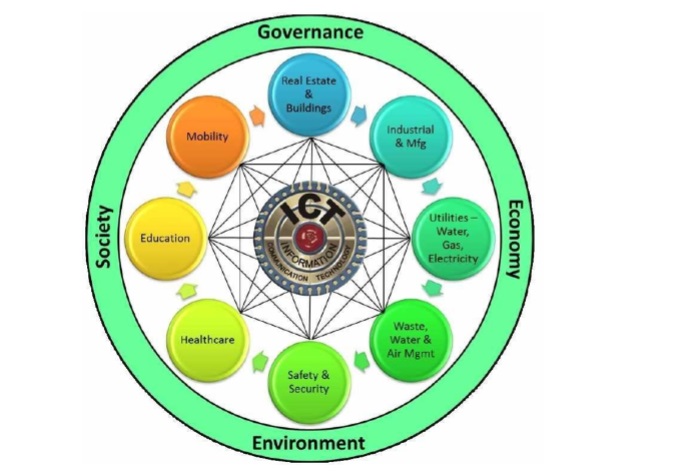“A smart sustainable city is an innovative city that uses information and communication technologies (ICTs) and other means to improve quality of life, the efficiency of urban operation and services, and competitiveness while ensuring that it meets the needs of present and future generations with respect to economic, social and environmental aspects”.
The number of people living in cities outnumbered the number of people living in rural areas as a result of migration to cities. Cities are accountable for the emission of greenhouse gases and consumption of energy. The poorly connected infrastructure of cities led to traffic jams and the shortage of water and electricity.
ICT:
Sustainable urban development concepts generate awareness of the use of resources to produce
the required amount of products for various processes in cities in a judicious manner.
Smart cities use ICT as an enabler to remediate the problems which are faced by cities now, like
resources, energy, mobility education, environment, waste management, housing, and jobs.
The migration to urban areas in search of better employment and living conditions and how dwellers of a city perceive their own sense of well-being created a lack of resources, in the course of time. The multidimensional nature of the Quality of Life incorporates basic needs such as– water, food, shelter, health, jobs (economy), safety and security, education, culture, environment, social equity, technology, and innovation which leads to the well-being of the society.
IoT:
The Internet of Things (IoT) is a structure in a smart city that includes physical devices, modern
automobiles, smart or green buildings, and essential electrical devices which are used on a consistent basis and are connected over the internet so that they can accumulate and exchange data amongst themselves. These are able to self-organize and communicate with other devices without human intervention which is a real advancement in technology.
IoT can be viewed as a global infrastructure for the world of information. By 2020, over 50 billion things will be inter-connected through IoT. The extensive application of IOT allows smart city projects to take shape all over. Designed to support smart cities, IoT uses the latest communication paths to make services reach the dwellers of a city. Home automation, healthcare via mobile, manufacturing automation, elderly assistance, medical aids, automotive, smart grids, and intelligent energy control, traffic management are some of the examples which come under the domain.
Smart cities make the use of smart things to carry out various aspects and functions of a city such as
traffic control, connecting with other cities, energy efficiency and pollution control. Employing latest techniques which are starting to show commitment regarding energy efficiency could help in lowering the power consumption of a city which leads to a carbon sink, which is a crucial reason for climate change.














Add Comment